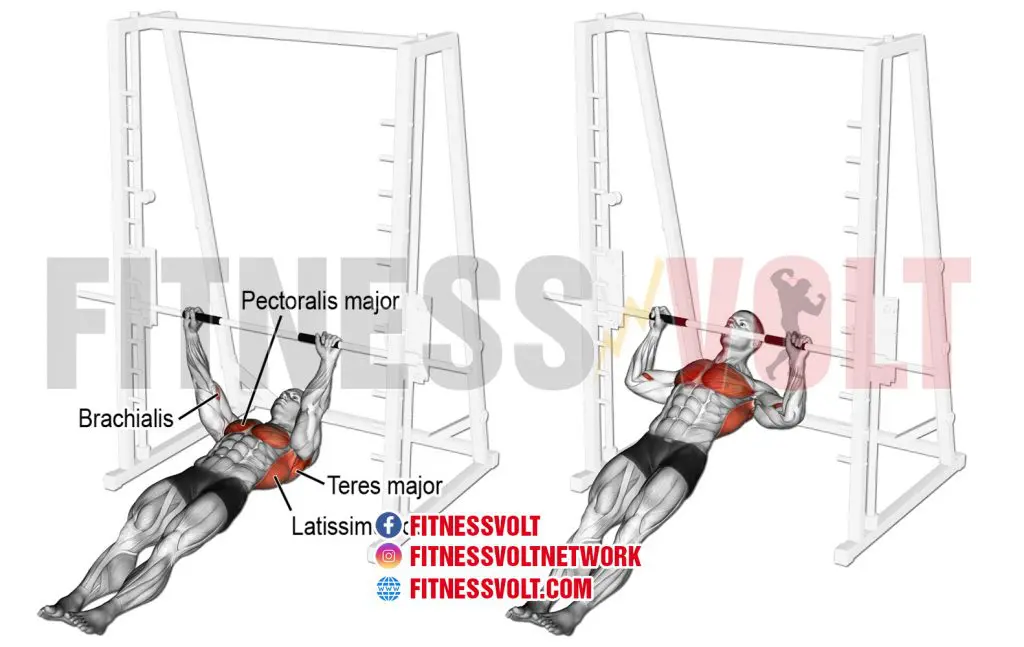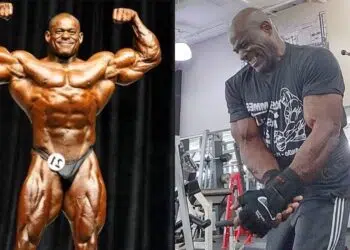Today we have a back and bicep workout for you that may look different than your typical routine. But that’s how you make new gains, right? Mixing things up can stimulate more muscle fibers to force growth, not to mention, it keeps you from boredom.
The back and bicep muscles pair very well together and if we use the right exercises/techniques, then the sky is the limit regarding potential results. It’s important to understand that the biceps are heavily involved during most back exercises and this is a key piece of information if you want to make big progress.
Related: The best workouts for bigger, stronger back
Therefore, we have the perfect routine that’ll help you to maximize your resources and build lots of knowledge on how to build muscle and strength in the process.
Back and Bicep Workout
Because the biceps assist during most back exercises, you’ll want to train your back first, using compound movements. The reason being is you’re able to lift the most amount of weight possible when training back since it’s such a large area of muscles that make up the upper posterior chain (backside of the body).
Consequently, the muscles of the back require a bit more training volume. The biceps, on the other hand, are a relatively small muscle that has two heads. Therefore, they don’t need as much work to grow and you risk overtraining by doing too much.
Level Up Your Fitness: Join our 💪 strong community in Fitness Volt Newsletter. Get daily inspiration, expert-backed workouts, nutrition tips, the latest in strength sports, and the support you need to reach your goals. Subscribe for free!
Do this workout a minimum of once but no more than twice per week (rest at least 5-6 days rest between workouts). Follow the routine as long as you’re making progress and vary your sets/reps to continue making gains.
Here’s the workout…
Inverted Row (3 sets x 10-12 reps)
The inverted row is a relatively simple (we didn’t say easy) exercise for most people, that doesn’t place a lot of stress on your lower back. Although, you still have to maintain a rigid and neutral torso. Therefore, you’re already engaging the lower back to an extent by having to stabilize your core of which the lower back is a part of.

This exercise works the upper back muscles which include the rhomboids, traps, lats, spinal erectors, and even the rear deltoids.
- Do two sets of the inverted row with your feet on the floor and then if you want to increase the difficulty, elevate your feet onto a bench or something of similar height. Then, you’ll do 3 full working sets following the two warm-up sets.
After you do a few sets of inverted rows, you’ll be ready to move on to something a bit more involved.
Read: How to do inverted rows at home – strong back and bigger biceps
V-bar lat pulldown (3 sets x 8-10 reps)
This such an amazing, feel-good exercise that you can go hard and heavy on. This movement works all of the back muscles but it’s a very good option for building the latissimus dorsi muscles or lats for short. It’s the largest back muscle that looks like you have wings when fully developed.
But by using a v-bar or close-grip neutral bar, you’re keeping everything tight and close which can allow you to pull with lots of power.
To do it:
- Grip the bar with both hands and secure your thighs under the padding.
- Keep your shoulder blades back and then lean slightly back.
- Pull the bar into your mid-chest area and squeeze your back muscles.
- Extend your arms slowly while leaning just slightly forward.
- Repeat by pulling the bar back down and leaning slightly back at an angle
Here’s a great video example…
Barbell bent-over row (3 sets x 5-7 reps)
In one study sponsored by ACE (American Council on Exercise), researchers pit several of the most common back exercises up against each other. And the bent-over barbell row actually came out on top for best overall back exercise. (1)
It showed symmetrical muscle activation for the lower and upper back which makes it a must-have tool in your arsenal. A big benefit of this exercise is that it’ll improve lower back strength (prevents pain). So if you’re new to this exercise and you feel a little lower back discomfort, it’ll actually improve as you continue to do the barbell bent-over row (or any bent-over row variation).
Plus your core, posture, biceps, and forearms will also benefit from this powerhouse of a movement.
Cable straight-arm pushdown (3 sets x 10-12 reps)
If you’re going to be strong at any compound lift then you need to develop scapular strength and stability. So whether you’re bench pressing, deadlifting, squatting, etc, this exercise is going to make a difference.
One important component of effectively performing compound lifts is the engagement and involvement of the lats. The arms need to be able to maintain a solid position with the shoulder blades retracted to achieve this. Without this stability and strength, you lose optimal form which can lead to injury.
Hence the reason why we’re offering the cable straight-arm pushdown to ensure you’re very strong in this position.
To do it:
- Grip the straight bar with a shoulder-width or slightly wider hand position and pin your shoulder blades back.
- Lean slightly forward and engage your core muscles.
- Pull the bar down into your upper thighs while simultaneously lifting your torso up and flexing your lats.
- Repeat.
Modified shrug (3 sets x 12-15 reps)
Shrugs are a very effective exercise for building size and strength in the lats. But by making a few changes to how most people do it, you can squeeze out the most muscle activation possible and build mountain-sized traps.
Now you can do this using a barbell, trap bar, dumbbell, cable, or Smith machine. However, dumbbells, a trap bar, and cables will feel better for most lifters due to the nature of the movement.
To do it:
Level Up Your Fitness: Join our 💪 strong community in Fitness Volt Newsletter. Get daily inspiration, expert-backed workouts, nutrition tips, the latest in strength sports, and the support you need to reach your goals. Subscribe for free!
If using a barbell or Smith machine, use a wide grip.
- While holding the weights in each hand, lean forward slightly and keep your shoulder blades neutral (not protracted or fully retracted. Keep your knees slightly bent.
- As you shrug, abduct (move outward) your shoulders at about 30 degrees and pull your elbows up to feel a more pronounced contraction in your traps.
- Lower your shoulders to feel a stretch in your traps and repeat.
Use a moderate to moderately heavy weight. Don’t use maximum poundages here.
To learn more about the modified shrug, check out our barbell shrugs guide (muscles worked, how-to, benefits, variations, and alternatives)
Weighted chin-ups/bodyweight dropset to failure (3 sets x 4-7 reps)
Now it’s time to hammer the biceps for sleeve-stretching mass…
The weighted chin-up is among our favorite bicep exercises because it maximally stresses the biceps at both ends where the muscles attach. And if you didn’t know, the biceps cross both the shoulder and forearm joints
Now, there’s no way to isolate one head or one end of the biceps muscles. However, we can emphasize and place additional stress on either area with a tweak in arm position. So when you position your arms in front of your body, you’ll place that extra stress near where the bicep crosses the shoulder.
The weighted chin-up is best performed by those who are decently proficient in the basic chin-up. Adding more weight will obviously increase the difficulty.
To do it, use a weight belt or place a dumbbell in between your feet. Choose a weight that’ll allow you to perform at least 4-7 good reps)
- Grip the bar using an underhand shoulder-width grip.
- Keep your shoulder blades back and don’t allow your head to sink into your shoulders. This is why scapular strength and stability is important.
- Pull yourself up to the very top and slowly lower yourself back down then repeat.
After you’ve done your weighted reps, take off the weight, and perform your chin-ups by doing only the top portion of the chin-up (head closest to the bar) until you hit failure.
Cable preacher curl (2 sets x 10-12 reps)
Cables keep tension on the muscle through a wider variety of angles which is not possible with barbells and dumbbells. For example, with the free weight barbell or dumbbell preacher curl, it’s much too tempting to want to rest in the fully flexed position at the top of the curl.

Well, the cable preacher curl definitely corrects this issue as the machine is always trying to pull the cable back toward its origin. The preacher curl also offers a larger degree of tension on the long (outer) head when the elbow is close to full extension. (2)
Therefore, we can see how using different techniques can maximize the activation of certain areas.
Incline dumbbell curls (2 sets x 10-12 reps)
In one scientific review of a study, it was discovered that the incline dumbbell curl resulted in considerable neuromuscular effort throughout the full range of a repetition. This was determined from a group of 22 male volunteers who performed the incline and preacher curl. (2)
As a result, it was concluded that the incline dumbbell curl is a preferred exercise for developing significant biceps strength. Well, this is definitely going to benefit your biceps training overall.
The incline dumbbell curl also places a great stretch on the long (outer) head of the biceps because your arms are positioned behind your body. So, it can actually maximize the emphasis on this head.
Dumbbell reverse-grip concentration curl (3 sets x 8-10 reps)
To wrap up the workout, we’ll finish off with the dumbbell reverse-grip concentration curl.
Now, one ACE-sponsored study showed the basic dumbbell concentration curl to elicit the most muscle activity when compared to other popular bicep exercises. That doesn’t mean it’s the best overall, but for pure isolation, it’s very effective. (3)
Not to mention, you’re able to improve your mind/muscle connection which allows you to maximize your ability to feel the contraction in your biceps.
John Porcari, Ph.D., and department head of the University of Wisconsin—LaCrosse and its Clinical Exercise Physiology program had this to say about the concentration curl.
“When you look at it, the concentration curl was significantly better than anything else. And I think the reason is that you’re really isolating the biceps muscle more so than in any of the other exercises”. “Some of the other exercises called into play the anterior deltoid or the front of your shoulder more, and for a lot of those, it’s almost natural to just swing your whole arm or shoulder forward to stabilize before you lift”.
So if we apply this knowledge to a variation of the concentration curl (dumbbell reverse-grip concentration curl), we should expect the same outcome.
The key to experiencing the best possible results with this exercise is to stabilize your arms against your inner thigh and maintain this position throughout the exercise.
Wrapping Up
This back and bicep workout should really do the trick. It’s planned strategically so that you can maximize your efforts and results. Yes, it’s a decent amount of volume but that’s not a bad thing at all as long as you’re not doing it too frequently. So, make this workout a part of your back and biceps routine and see some serious gains!








